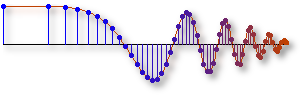Overview: In Appendix A, the basic manipulations of complex numbers
are presented. The algebraic rules for combining
complex numbers are reviewed, and then a geometric viewpoint is
taken to explain various operations by drawing vector diagrams. The
following four significant ideas will be pointed out concerning
complex numbers:
- Simple Algebraic Rules: operations on complex numbers \(z=x+j\, y\) follow exactly the same rules as real numbers, with \(j^2\) replaced everywhere by \(-1\).
- Eliminate Trigonometry: in polar form, \(z=\cos(\theta) + j\, \sin(\theta)\) appears in formulas, so many trig identities reduce to simple algebraic operations on a complex number.
- Represent Vectors: a vector drawn from the origin to a point \((x,y)\) in a two-dimensional plane is equivalent to \(z=x+j\,y\). The algebraic rules for \(z\) are, in effect, the basic rules for vector operations. More important, however, is the visualization gained from the vector diagrams.
- Represent Sinusoids: the magnitude and phase of the sinusoid are used to define the polar form of a complex number. Then operations such as adding sine waves are reduced to adding complex numbers.
Demos - MATLAB 3
PhasorRaces began as a speed drill for testing complex addition.
Now it includes many other related operations that can be tested
in a "drill" scenario: adding sinusoids, z-transforms, etc.
A timer starts as soon as the problem is posed, so that a
student can try to solve questions quickly and accurately.




